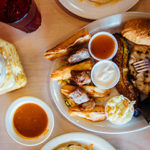1. Can you create a gluten-free menu or indicate what is gluten-free on your menus?
2. Do you have a dedicated gluten-free fryer?
(For those with celiac disease, reactions can be caused by food that is fried in the same oil as gluten-containing foods.)
3. Is your staff, including your wait staff, trained to meet the needs of people with food allergies?
No matter how much effort the kitchen staff has put into food preparation, it could all go to waste if the wait staff is not trained on protocols as well as in communicating about food ingredients and preparation.
4. Are you going to bring in additional gluten-free items, rather than subtracting food items from the menu?
Food safety is the most important thing, Cafferty said. But “if you serve [gluten-free] bread with dinner, or a [gluten-free] dessert beyond a fruit plate or sorbet, [gluten-free attendees] are forever indebted and loyal.”
5. Can any of your sauces and soups be made gluten-free?
Many sauces and soups are naturally gluten-free, Cafferty noted. As in question 4, adding a sauce to a plain chicken breast goes a long way toward making people happy.
6. Can you offer gluten-free breakfast items?
Continental breakfast, often consisting of yogurt with unknown ingredients and gluten-containing granola, muffins, and bagels, can be a culinary desert – not dessert – for attendees on a gluten-free regimen.



